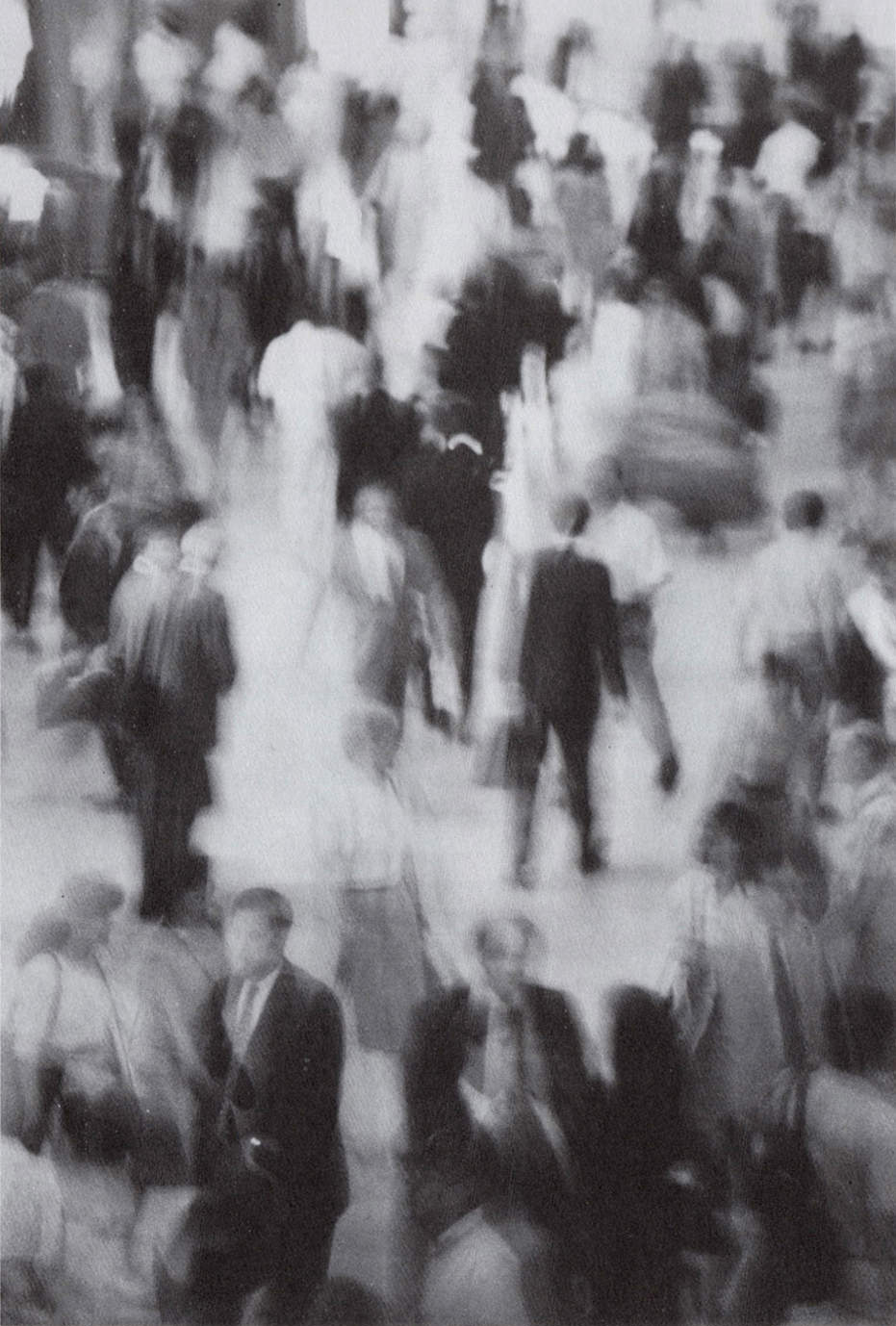
Devon Dikeou, Rush Hour, Grand Central Station, black and white photograph, 1988
Devon Dikeou’s second solo presentation at James Fuentes, “Here Is New York (E.B. White)” features what are among her earliest artworks made as a young artist in New York City. There are two security gates paired with other security-oriented materials—glass blocks and acrylic sheeting—and an enclosed kiosk, all of which one would regularly find on the streets of New York (depending on the hour). These works set a seminal precedent exploring spaces and objects of transition, which would later find other forms and subjects as her career progressed. So with this exhibition we return to the root of things, to revisit where it all started got Devon and an era of heavy analog materiality that is changing with the sleekness of this post-digital era. “Here is New York (E.B. White)” is on view September 8th – October 7th, 2018.
Interview by Brandon Johnson
These security gates represent to you the “in-between.” Other works of yours also engage in this realm. What is it about the “in-between” that appeals to you?
John Baldessari said, “Instead of looking at things, look between things.” I ran across this quote only in the last year, which was in a book of collected quotes by artists under the table of contents’ moniker of “Advice.” And it made a lot of sense to me. Many of the series in my practice touch on this “in-between.” The curtain behind the comedian, the flower that accompanies the big picture, the chair that seats the Pope, the minimalist donation box soliciting funding, the plant in the mall that is between decoration and commerce, the jazz musician (like they often are) forgotten, the directory board announcing the exhibition. I’m interested in those spaces that are shared by all those transactional viewing experiences . . . the viewer, the artists, the gallerist, the critic. And more. What they all signify is something that I’ve always reflected on, and done and it comes down to this, which is very similar to the Baldessari directive. Look at the space between the leaves of tree, not the leaves themselves.
The show is titled “Here Is New York (E.B. White)”. You often use literary references to support and deepen your conceptual installations, adding a dimension of the human condition to cerebral artworks. In this instance, a quote from E.B. White. What do these titles mean to you?
There is this great bookstore called Three Lives in the Village near an apartment on Christopher where I once lived. It was and is spectacularly curated so to speak, and I maybe learned something about curating from that bookstore. It is tiny, not like the Strand—which is all inclusive, and where you can go for miles and days browsing. Three Lives had to strategically choose what to shelve, much less select or highlight. I’ve found some of my most beloved and cherished tomes there directed by the Three Lives curation, one being the slight thin paperback booklet that can be read in an hour called, Here is New York. It’s by E.B. White, who I only knew from Some Pig! and Charlotte’s Web fame. I quickly absorbed his adult message—and learned of his great, underrated legacy as a non-fiction writer—and re-examined the childhood tales I so loved. What is Charlotte, a spider, who weaves a web. What is New York, a web us flies have to navigate.
Security gates have come to represent a low-key quintessential part of New York street life. How else does this show find its groove in the Big Apple?
When I came to New York, it felt like a world of possibility. But it was equally dangerous as was it was joyful. Lots of artists have explored this, from Nan Goldin to the Ramones, Blondie to Robert Mapplethorpe. They had all the stages covered, so I worked on the background . . . The gates were as ubiquitous then as they are now, but a universal signifier of urban environments worldwide. The gates seemed like the perfect segue.
The industrial nature of the gates is representative of an engagement with functional ready-made materials positioned within a conceptual framework that characterizes some of your early works. What was the draw of these materials and subjects for you at the time?
New York. Of course, that was the platform, and I’ve been discussing this with Cortney . . . The difference between platform and medium . . . But I think the gates are the medium. And nothing can be done without Duchamp. So those gates are the Duchampian gesture/medium in and on the platform of New York.
Being some of your first works made as an artist in New York, what does it mean to show this work in a contemporary context—over 25 years after they first premiered?
I remember going to an exhibition at the Whitney (Breuer Building) in the ‘80s of Vija Celmins and Dan Graham. I just loved it. The wall texts kept touting a phrase which I thought odd at the time . . . “An Artist’s Artist.” I thought it was a slight in a way, because the work was incredible, those dense drawings of oceans, surface images of housing—both reflecting something immeasurable, and perfectly and specifically dated. Now these artists are larger than life as they should be, I would only be so happy to be called an artist’s artist even if it’s 25 years or more, later.
Finally, in revisiting older works, can you see any ways in which your work has changed? And ways in which it has stayed the same?
I am an archivist by nature, save everything, never know when you’re gonna need it . . . All things everything, a page from Warhol. But funnily enough, the gate works physically disappeared. Gone, and yet always felt like that friend you see again and pick up with as if no time has passed . . . Or a time capsule you open and greet with abandon. I’d look at the photos of the gates and long for the youth and early conviction of that other time. So it’s nice, a lovely present to see them again, to visit with these old friends, and see what as a young person and thinker I was aiming for and then as a more mature artist now, how I picked up those threads . . . And the ability to make a relation “between” them, there we go again. And so their being made again, these gates, makes me smile. Archive that, Devon.

Kenny Schachter, Kenny Mostquito, 2016, Digital c-print on plexiglas, 10 x 6.5 in
Kenny Schachter, art world bad-boy, bares it all in his deep-diving retrospective exhibition at Rental Gallery in East Hampton, on view through October 31st, 2018. We catch up with Kenny via text to discuss the big show, what led up to this moment, and what is to follow . . .
Interview by Devon Dikeou
You started curating in the late ‘80s, early ‘90s . . . I particularly remember the German show and stuff in your 1st Avenue flat. But also stuff at BACA Downtown, above 303 in the vacant Massimo Audiello Gallery on Greene St. And despite your Eulogy . . . the shows were amazing, not “a mess,” giving so many artists the platform to show at a time when there were so few. Give us the “best of” of those early shows . . .
My second show, “Decorous Beliefs,” highlighted the worst attributes of humans: racist, sexist, and generally prejudicial behavior. You serving up blood-rare sandwiches to be devoured by the derelicts of the early ‘90s emerging art scene we called friends. Then I clocked Roberta Smith in the space one day and couldn’t believe my luck—to this day I am enamored of every word from her keyboard. When I approached her and began explaining the intent of my show, she reprimanded me in no uncertain terms without expressing an emotion: “If I needed art explained to me, I’d never leave my house.” Ouch. I’ll admit to a few tears when she departed.
Talk about the segue from younger artists to mid-career or older artists and the importance of working with some of the major architectural thinkers of our time.
For a good long time, say close to ten years, I couldn’t tolerate a conversation with an emerging artist. I felt they were literally sucking the breath out of my mouth; then, so emboldened and strengthened, they’d walk all over me. No joy. So first I launched personal and professional relationships with Vito Acconci and Zaha Hadid; I am in awe of talented, brilliant people and was, like a fan, simply in thrall of their company and accomplishments. Not to mention I commissioned many projects and did countless curatorial and writing projects dedicated to both. I thought maybe some of the stardust might be catching. After getting soul-sucked by young artists for decades, then as an acolyte of the greats, I needed money and began secondary dealing. I was a bad lawyer, a bad tie salesman, and a worse art dealer.
Who are your mentors . . . Who are your enemies ; )
My mentors or rather the people that inspired me (I didn’t get much help from anyone) are Vito Acconci, Zaha, Paul Thek, who was an example of the notion that sometimes, being too good is too bad—he was a brilliant master of many media but was simply too far ahead of his time and lived too much of the time abroad and lost support after an early career spurt. He failed miserably in life and work, only to be celebrated in death with retros at the Whitney and Reina Sofia (I advised on both and wrote regularly on his work). My enemies are anyone hypocritical, not forthright or transparent. I’m often contradicting myself so sometimes I can’t stand myself either.
Speak about the relationship you have with your work to the market—be it visual, critical, or otherwise . . .
I love the market. Sure it could be ruthless, hideous, disingenuous, reductive . . . but really those characteristics apply to the players. Art and money have been sexing it up for centuries, from Durer to Rembrandt to the private plane flying the handful of today’s artrepreneurs. I don’t care—I need art and I need money to make and pursue it. My writing chronicles the misfits and general commercial activity at fairs and auctions so it gives depth and meaning beyond just recording sales. I am after the behavioral dynamic of social, political, and economic interaction as it applies to art. When it comes to selling my own work, I am a nervous insecure wreck and run from the dialogue.
What’s the thing that surprised you about playing all these roles in the art world and how it affected all these roles, in terms of practice in general, and the retro?
I stuck to it for thirty years. It’s a miracle I never compromised and that I even have an audience. I am so humbled and surprised I can’t believe anyone reads me or looks at other stuff I’ve been up to. I always thought I was kind of unlucky, stuck in the margins, and though by nature I will always be located outside the norm somewhere, I just can’t believe how things have gone in the past five years. Now I’m an old emerging artist that is selling. At a small gallery when they are said to be under siege. I am pinching myself now.
You were involved from the beginning of zingmagazine . . . And have done two books with us . . . How do you go about doing a retro or exhibition vs a printed project?
For me it’s all an organic mush. It just comes out of me and I don’t differentiate from any of my pursuits, be they as far afield as selling a Picasso and making a video or curating my kids into shows and supporting their work. I have a very democratic outlook on life and relish that I’ve never had a repeating day in my life. Though sometimes I feel like I’m merely treading water and stuck in the film Groundhog Day. I must say of all the disparate things I’ve done, having this art show transformed my life, for the first time I almost think of myself a real artist. Scary—for me and you.
Basically, how did you get a show at Rental and what made you want it to reflect the idea of a retrospective . . . in terms of you as a curator, gallerist, artist, collector, dealer, critic, writer, person extraordinaire of the ’90s art scene. How much is real how much fiction?
No fake news here, what you get is what you get: me stripped bare, naked, humiliated, walking down main street with strangers looking at my . . . oh never mind. Making art so publicly for the first time in more than 15 years has been an extraordinary experience. I can’t even recall how Joel Mesler and I met a few years ago, but he is a younger version of me, namely a jack of all (art) trades—making, curating, dealing and gallery-ing. He’s hilarious, supportive, talented and fun, as an anti-religionist, it’s not an easy to mouth, but I’ve been blessed.
What’s on deck?
Family Guy, the fourth installment of exhibits I’ve curated incorporating my family (though I mostly can’t stand any of them), and works we’ve all lived with for decades, at Simon Lee Gallery in London, then another one-person show in LA in Feb at Niels Kantor during Frieze/Felix art fairs in town and then . . . more of the same. I can’t temper my crazy love and passion for looking at, thinking about, and writing on art. And now, I am afraid to disclose, making it seems to be the next area to apply myself even further. I just can’t help myself baring it and sharing it. Sorry folks!
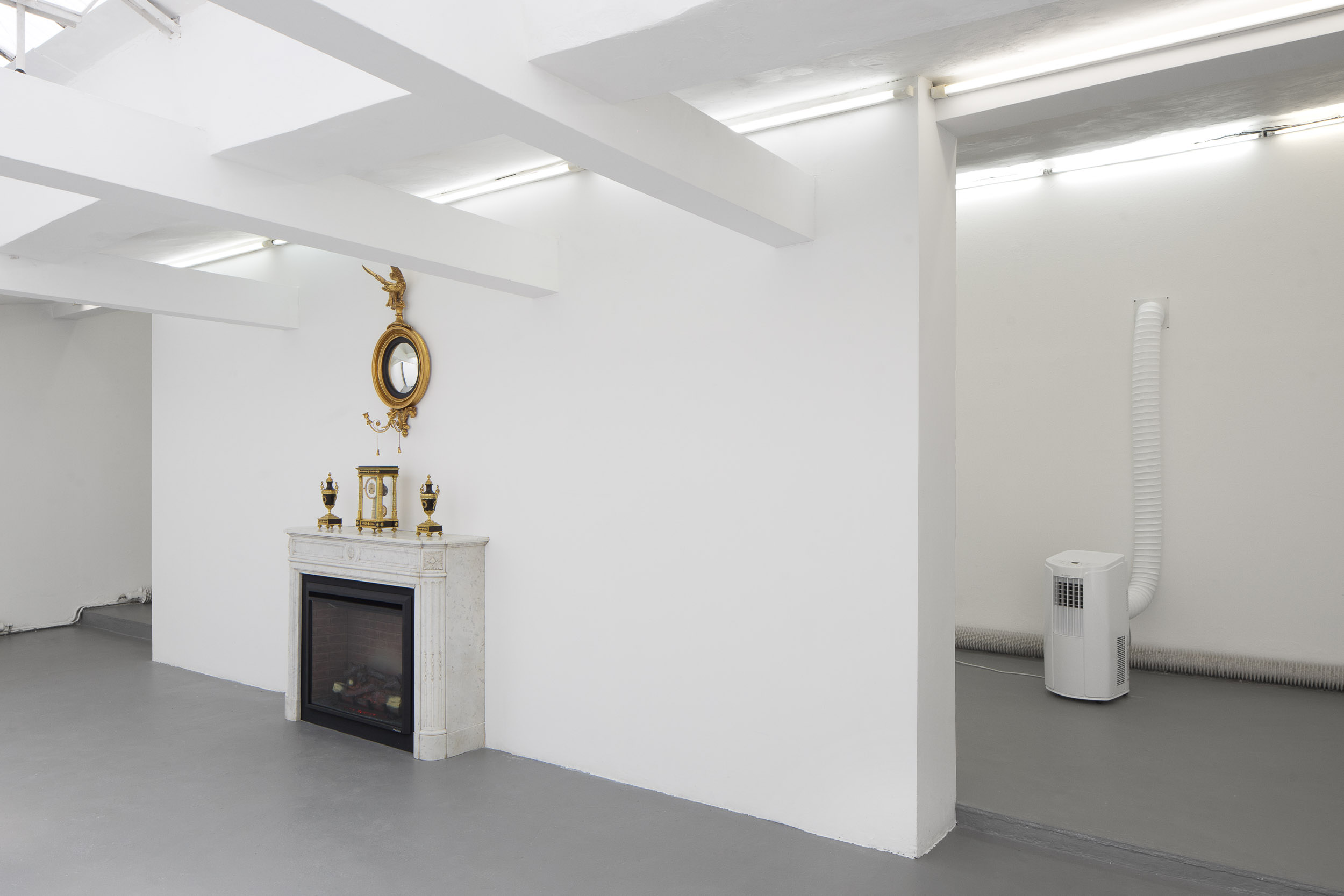
Devon Dikeou “Tricia Nixon: Summer of 1973” installation view
Cortney Lane Stell is Executive Director and Chief Curator of Black Cube, a nomadic contemporary art museum based in Denver, Colorado. Michal Novotny is Director and Curator of FUTURA Center for Contemporary Art in Prague, Czech Republic. In their first collaboration, these two organizations have partnered to host Black Cube fellow Devon Dikeou as a FUTURA artist-in-residence in Prague. This resulting exhibition, “Tricia Nixon: Summer of 1973” is on view at FUTURA through September 16, 2018, alongside concurrent exhibitions by Andrew Norman Wilson and Lenka Vitkovka.
Interview by Brandon Johnson
In collaborating to produce Devon Dikeou’s “Tricia Nixon: Summer of 1973”, each of you are coming from very different cultural and historical backgrounds. How do you see an exhibition focusing on late 20th-century American politics relating to its context of Prague, Czech Republic?
C: The collaboration is simple—it focuses on an exchange between two countries, two nationalities, two artists, and two curators. Part of the vision of the exchange is to create conversation and share in the act of giving one thing and receiving another. So, this exhibition is part of that larger project.
In relation to the exhibition, for me it is mostly about memory—Devon’s childhood recollection of two concurrent news stories . . . a gas crisis and another about Nixon’s daughter keeping a fire and air conditioner on in the White House during this time. For me, seeing the architecture in Prague oozes with historical memory, ranging from Baroque and Renaissance architecture to more contemporary additions coming from the country’s Communist era.
This sense of the haunting of the past is very present in my experience of Prague and also these artworks. It reminds me of a text-based artwork by Anthony Discenza who produced parking signs that said “this is about something that happened a long time ago that continues to affect us today.” In many ways, I think these works also touch on ongoing global, social, and political issues.
Though the stories that Devon culled together are rather obscure—especially for a Czech audience—the air in the exhibition space is opulent (literally warm and cool). This thread roves through the exhibition and gently teases out concepts of ecological challenges, service, and personal comfort—all of which are concerns that traverse national borders.
Michal, I wonder how you read all of this . . . do you catch the same drift? Does the exhibition feel American to you?
M: It feels very American. But, if not the world, at least the society I live in, has been culturally colonized by the USA, so it doesn’t feel incomprehensible. Also, American politics is very present here in the media, maybe even over-present, at least what comes to the real material, economical, locally-political impact, so for me the parallels with the current US political situation are somehow explicit. Maybe even more than they really are there.
However, I do consider the program locally, and what is important for me is that Devon’s exhibition presents something artistically familiar but also uncanny. We have a long history of conceptual art, it is still the dominant discourse, but this exhibition shows something a bit different. Maybe it’s the unnecessity to poeticize everything, there is something a bit more raw in the situation encountered. Even if it may seem narrative, it’s ultimately not-so-narrative.
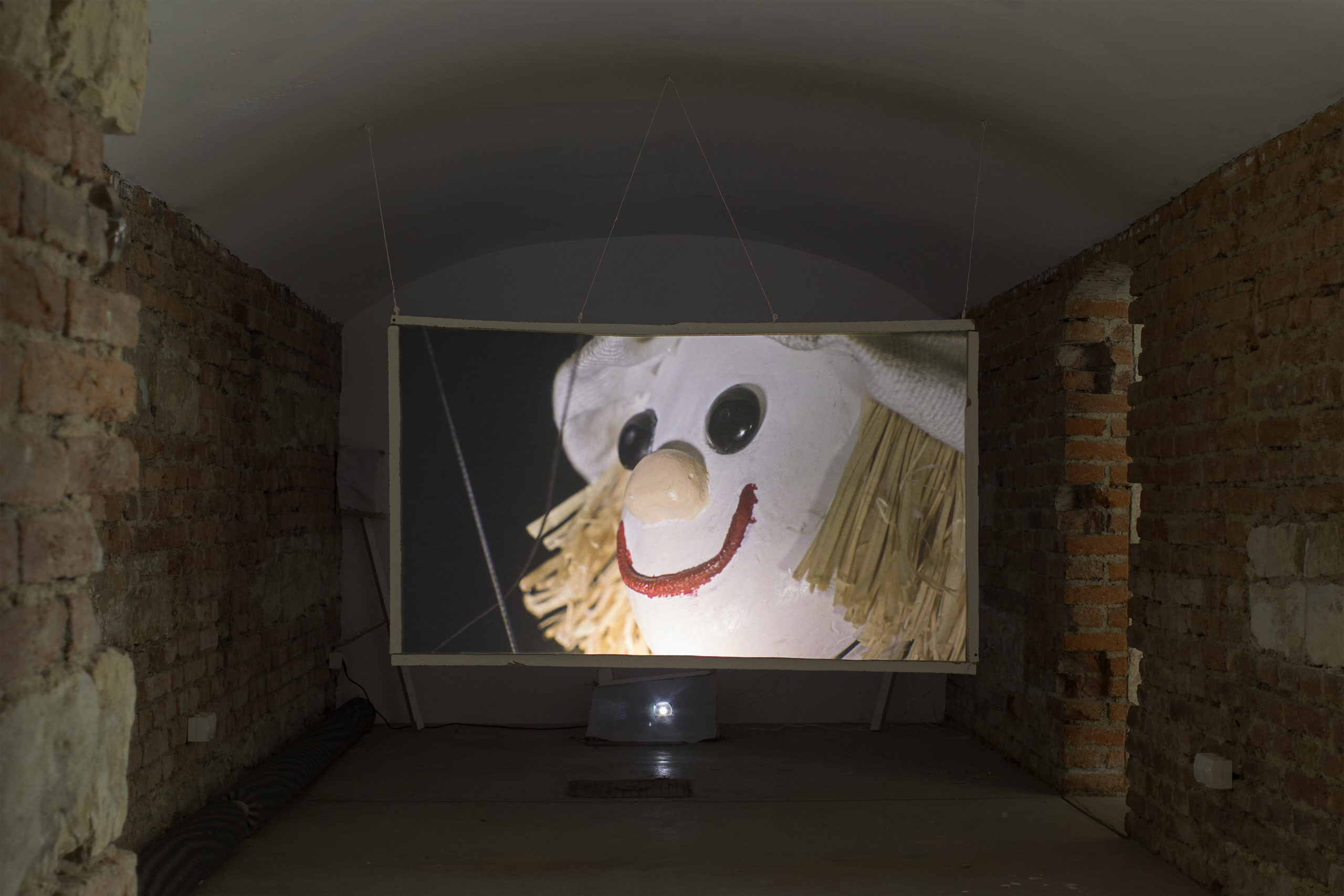
Andrew Norman Wilson “Andrew Norman Wilson” installation view
Going a step further, how do you see “Tricia Nixon: Summer of 1973” interacting (nor not) with the other two concurrent exhibitions at Futura, Andrew Norman Wilson: Andrew Norman Wilson and Lenka Vitkova: Slope? Michal, is there an attempt by Futura to consider in advance how the artists/curators will align, or is this occurrence more happenstance?
M: Of course there is. It is not by chance the two American artists whose solo exhibitions we open this year open also at the same time. On the other hand, the togetherness goes also in contrast, as we hope that if people do not like one exhibition they may like the other. So Lenka’s exhibition is on purpose unpolitical, meditative, intimate, and painterly.
Between Andrew and Devon I see a lot of structural meeting points even though the formal expression may be very different. For example, in the Ode to Seekers video the image of an oil tower merging into a mosquito head piercing human skin and the two remixed pop songs one saying “if it makes you happy, it can’t be that bad” second “I don’t care, I love it” makes a nice echo to Devon for me.
C: I see the three exhibitions in a more complimentary and contrasting way, rather than the connections between them. Given that the three exhibitions are on three floors, they sit like a layer cake in my head, or perhaps like an upside-down body. Lenka, who is on the top floor, being the feet or the earthly sensibility. Her paintings have a materiality to them and are quiet, gentile, and careful (and some paintings are literally feet). Devon, who is on the middle floor, is the exterior senses—stomach, ears, and skin. Her exhibition is rooted in physical sensations and the interconnection with the sociopolitical world around us. And Andrew’s work, which is in the space Michal calls the dungeon, is rather philosophical in tone, residing in the head and projections of the world. For me the three exhibitions are lovely in their contrasts. The differences in materials and relation to the viewer are quite different. I also agree with Michal that Andrew and Devon’s works have more links between them—they are both immersive installations that share a sense of angst.
M: Yes, Cortney that’s definitely a good metaphor, also, in a way, all three exhibitions are about belonging or alienated body . . .
How did FUTURA and Black Cube get involved in this organizational exchange, and what is the next step?
C: Well, Michal and I first met at a curatorial intensive for Independent Curators International in New York. We have stayed in touch since then, Michal has visited Denver and helped install an exhibition back in the day when I was the gallery director at the Rocky Mountain College of Art + Design. Since then, we have wanted to collaborate and this seemed to be the perfect moment to do so. Black Cube’s program allows for exchange to easily happen and Michal has been doing a lot of outside curating.
M: We meet seven years ago at curatorial program in New York sharing a certain healthy skepticism towards art world functioning and somehow a peripheric position. At that time we both hadn’t served the institutions we are at now, so maybe it turned out to be a good idea to decide to stay where we were.
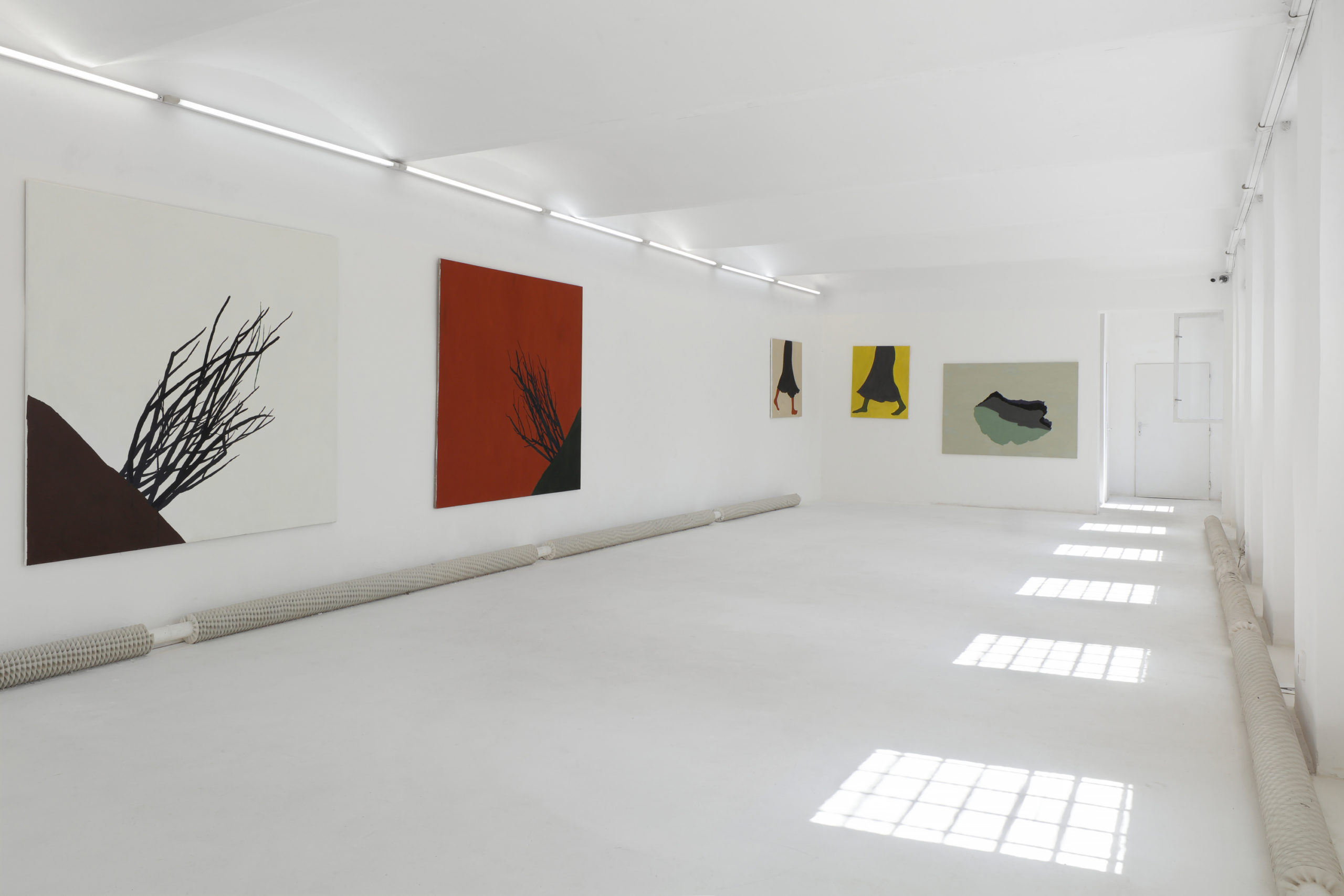
Lenka Vitkova “Slope” installation view
Finally, Cortney can you speak to the current state of contemporary art in Denver and what you hope for in the future? And likewise, Michael can you speak to the same in Prague?
C: Denver’s contemporary art scene is rather small, we have one art museum and one contemporary art museum—these institutions seem rather stable and have very prominent education departments. Since the 1980s the city has had a sales tax that helps fund the larger nonprofits in the area . . . because of this we have a rather top-heavy nonprofit scene and are skimpy on most other areas of the ecosystem. This has created a super small commercial gallery scene, and even fewer artist-run spaces. My favorite part of the scene is the artists, there are some truly amazing people here . . . ranging from those that are embedded in the global contemporary art scene such as Devon to outsider artists that take use of the freedom of the West. But this is all changing as the city is going through a huge growth spurt; I imagine these changes will affect the scene in many ways, currently it seems like the biggest sign of this change is that a lot of artists are feeling the rising rent costs and consequently are moving outside of the downtown area or leaving Denver altogether.
M: Prague’s scene has changed entirely in the last 10-12 years and I dare to say FUTURA helped it. What used to be an entirely local scene operating via underground friend circle one-night event spaces is nowadays, along with Warsaw, the most developed scene in the former Eastern Block with maybe 40 subjects active in a city of 1.5 million. What I tried to create when I took over at FUTURA was a certain bridge for the international to come Prague but also for the Czech artist to get abroad. This slowly became more and more the export and also support to local artist. As the international presence becomes ordinary in Prague, we increasingly focus on supporting the local artists.
However, the scene has still one big problem and that is the absence of large functioning state institutions. There is still no museum of contemporary art in Prague and the sort of substitutes such as the National Gallery or the supposed to be Kunsthalle Rudolfinum do not replace this lack, and due to personal, political, and inner-logic reasoning, fail to be both locally and internationally respected institutions. This however also influences all the rest of an otherwise dynamic and developed commercial and non-profit scene. Artists in their 40s/50s/60s still exhibit in the alternative spaces, as there is no one to do them the proper catalog retrospective, commercial galleries have no sales to institutions, as institutions do not collect anything, and there are no coffee table books to show to collectors, as institutions do not publish anything. Non-profit spaces like FUTURA are competing in the style of low budget, often younger artist exhibitions, with museums that should be doing something else entirely on the hierarchy pyramid. On the other hand, all the scene, commercial galleries included, run on state support, which has maybe doubled over the last decade. It’s not easy securing funding—we are still only two full-time people working at FUTURA, running two venues, residency program, and doing 30 something exhibitions per year. While in most other European countries in the Western direction the state funding towards alternative art spaces is disappearing, in Czech Republic it grows every year. But I also think that in the end it is not a bad deal for the state and the taxpayers. The effectivity of labor is much higher in the small-scale operating spaces than in large institutions. The amount and quality of content we all create is definitely very cheap comparatively.
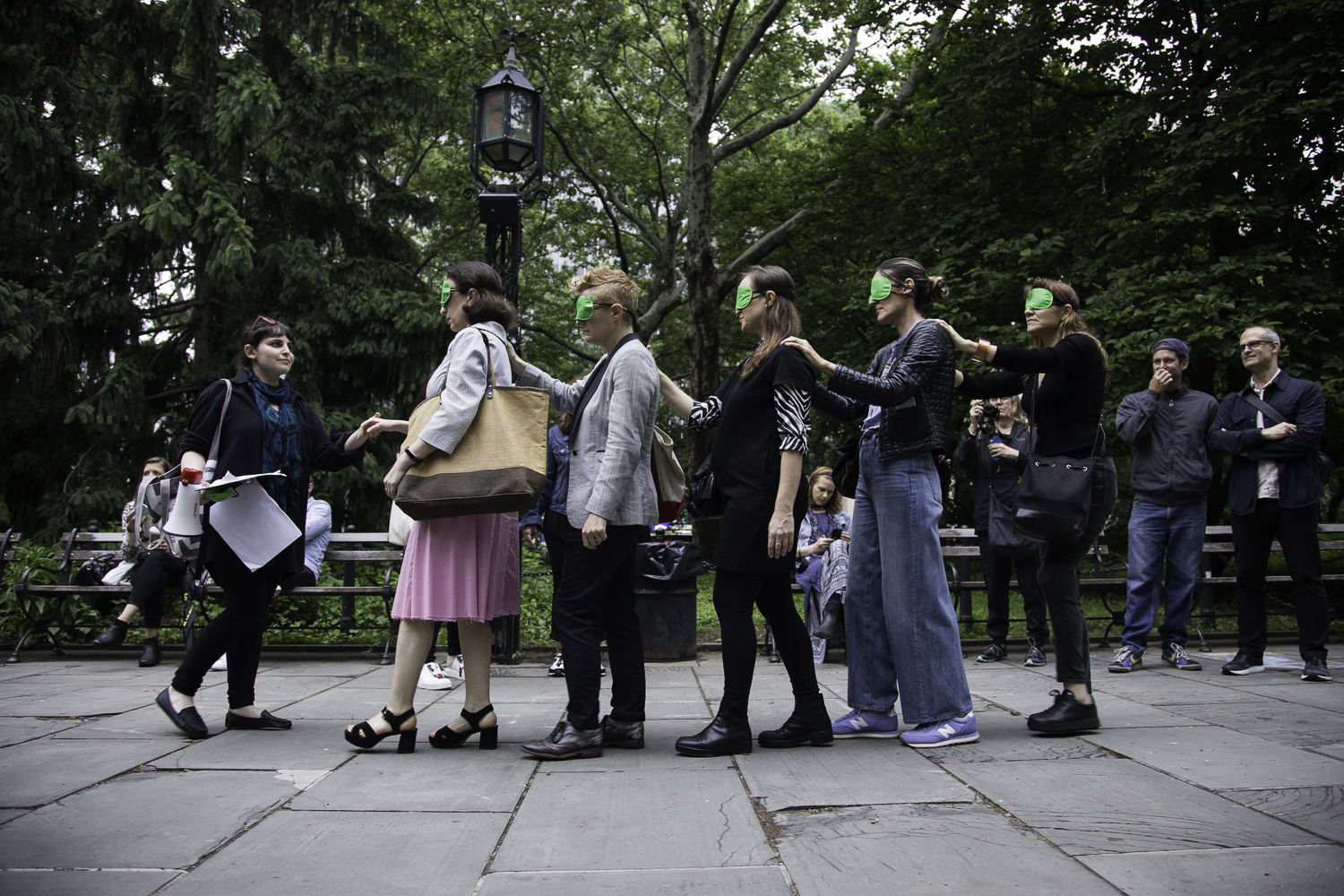
Sari Carel was born in Israel and lives and works in Brooklyn. Her work has been exhibited internationally in galleries and venues such as Artists Space, Nicelle Beauchene, Gavin Brown’s Enterprise and Dumbo Arts Festival in New York, and Tavi Dresdner and The Heder Gallery in Tel Aviv. She has recently partnered on projects with More Art, a New York based nonprofit that supports collaborations between professional artists and communities to create public art and educational programs that inspire social justice. These projects include Borrowed Light at Sunset Park, Brooklyn, in 2015, and Out Of Thin Air currently at City Hall Park in Manhattan. Out Of Thin Air is a multi-channel immersive soundscape of recordings taken from breathing workshops conducted leading up to the installation, in which respiratory illness, air quality, and environmental injustice are at the forefront. Out of Thin Air is on view through July 8th.
Interview by Brandon Johnson
How did you become interested in the breath?
My interest evolved from a few different directions that suddenly came together in this project. The first is actually a personal one. My sister, who I am very close with has been living with an incurable lung disease, lymphangioleiomyomatosis. She is also a philosopher and her diagnosis jolted her into thinking about illness as a philosophical tool. Her essays and books, as well as witnessing her harrowing experience of learning to live with a disabling and incurable illness have changed the way I think about the experience of being ill and more specifically feeling breathless, or gasping for air. Her work has showed me how exquisite breath is, and how fragile. I also work a lot with sound and its relationship to other mediums. So from a sound practice perspective it was interesting for me to zoom in on these gaps and gasps that audio engineer painstakingly try remove to enhance a recording. For this project I wanted to remove everything else and just let us hear and think about breath as a rich and layered vocabulary that is largely invisible to our noisy lives.
You partnered with master teacher Jessica Wolf to conduct therapeutic breathing exercises with New Yorkers living with asthma and other breathing conditions. Recordings from these exercises were used to create the public sound installation. As an artist, do you feel a social responsibility beyond traditional notions of aesthetic beauty when creating public artworks?
I come from a hands-on studio practice and am very committed to the poetics and manifold meanings that can be generated from working with materiality and imagery, in the broadest sense of the word. But over the last ten years I think there has been a steady move by me towards realms outside the art world and outside my world as well as an intense curiosity about other fields of inquiry and research.
This led to weaving other bodies of knowledge into my work, collaborating with scientists, musicians and mathematicians among others. In my exhibition Earth & Sky last year I collaborated with an ornithologist and commissioned work from a craft conservationist. These different kinds of knowledge entered the bloodstream of the work at a very early stage and present themselves very differently from each other throughout the development of the project.
My interest is not just in mining other worlds for materials but to make a series of connections and welcome a whole other set of priorities, principles and ways of thinking into the studio and into the exhibition space.
For this work I wanted to take it a step a further and to develop a work process that from the beginning is tuned into and relies on practices from other fields as well as partnerships with people outside the art world. The workshops were amalgams of a few different things: Participants learned from Jessica Wolfe methods of breathing and exercises to help them breathe in a more sustainable way. We also talked about theories of Illness and ways of thinking about breathlessness. We delved into the recording process both as participants as well as producers. Having all these different vantage points over a period of two hours and leaving with a new set of tools and new insights into breathing practices was an important part of this communal activity. The sounds generated from these actions accrued meaning and vitality in large part because they were the byproducts of doing something together, for real.
I am very occupied with the possibility of making things reverberate in more than one way. I try as an artist to push against the insularity that can sometimes run through contemporary art, and I am truly curious as to what aesthetic repercussions can be derived from and divined out of intersecting activities.
Out Of Thin Air, which was commissioned by More Art, also includes a diverse public engagement program for this very reason. Let art be the occasion for bringing together a variety practitioners, thinkers but also audiences. To have many conversations not just ones that revolve around art and to include activities that bring people together in an act of making and doing, not just talking and viewing.
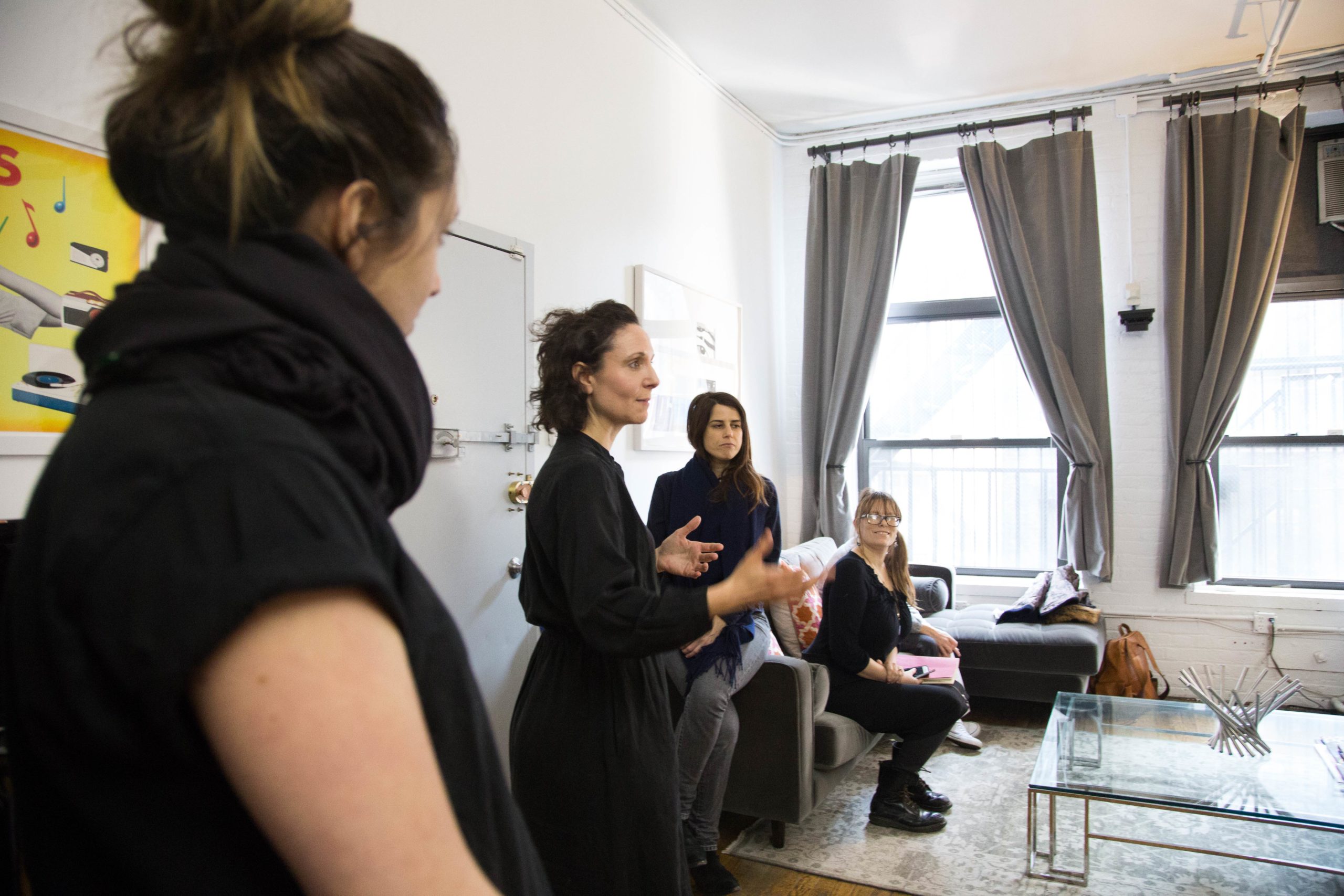
The site of the installation is City Hall Park. Did being offered a platform in close proximity to the epicenter for New York City government have an influence on this project?
Finding a location that fit the aesthetics and themes of this piece was a journey in itself. When the opportunity to present it in City Hall Park I was very much tempted by exactly that, before actually doing a site visit to determine if it would be feasible and be a good physical context for the piece. Considering breath, breathlessness and air as a commons that belongs to all of us is at the end of the day inextricable from policy.
What was your process for arranging the breath recordings from the workshops into a cohesive, public-facing whole? Anything you valued specifically in the recordings, and any impact you wished the final product to have on visitors?
Editing the strands of sound that I gathered throughout our activities and workshops was mostly done in my quiet studio. Playing around with the materials and trying out different sequences, types of layering and valuing how things come together but also the gaps that are created between different layers that don’t quite align with each other.
I ended up making three vignettes with various gaps between them. the silence in between is just as active as the parts that are full of sonic action. it allowed for a play between foreground and background and I hope they encourage the listener to tune into the sonic environment around them in a different way. Not just hear all the sounds and noises around you but listen and take in the textures they create. The 10 minute breaks between the plays of the complete breath composition aim for a more egalitarian act of listening. Art and site mesh in a changing, open-ended way.
Past projects of yours have also engaged with environmental concerns. Would you consider it a foundational role of your practice to bring attention to the world around us, both natural and unnatural?
Humans have evolved within a certain context, that context is planet earth. The environment is not something outside of me. My senses, with which I perceive space, landscape, language and art would not exist as they are without it. This relational process between the human animal and all other animals in the world as well as the landscape, the air, the horizon line and even gravity itself is at the essence of who we are as sentient beings.
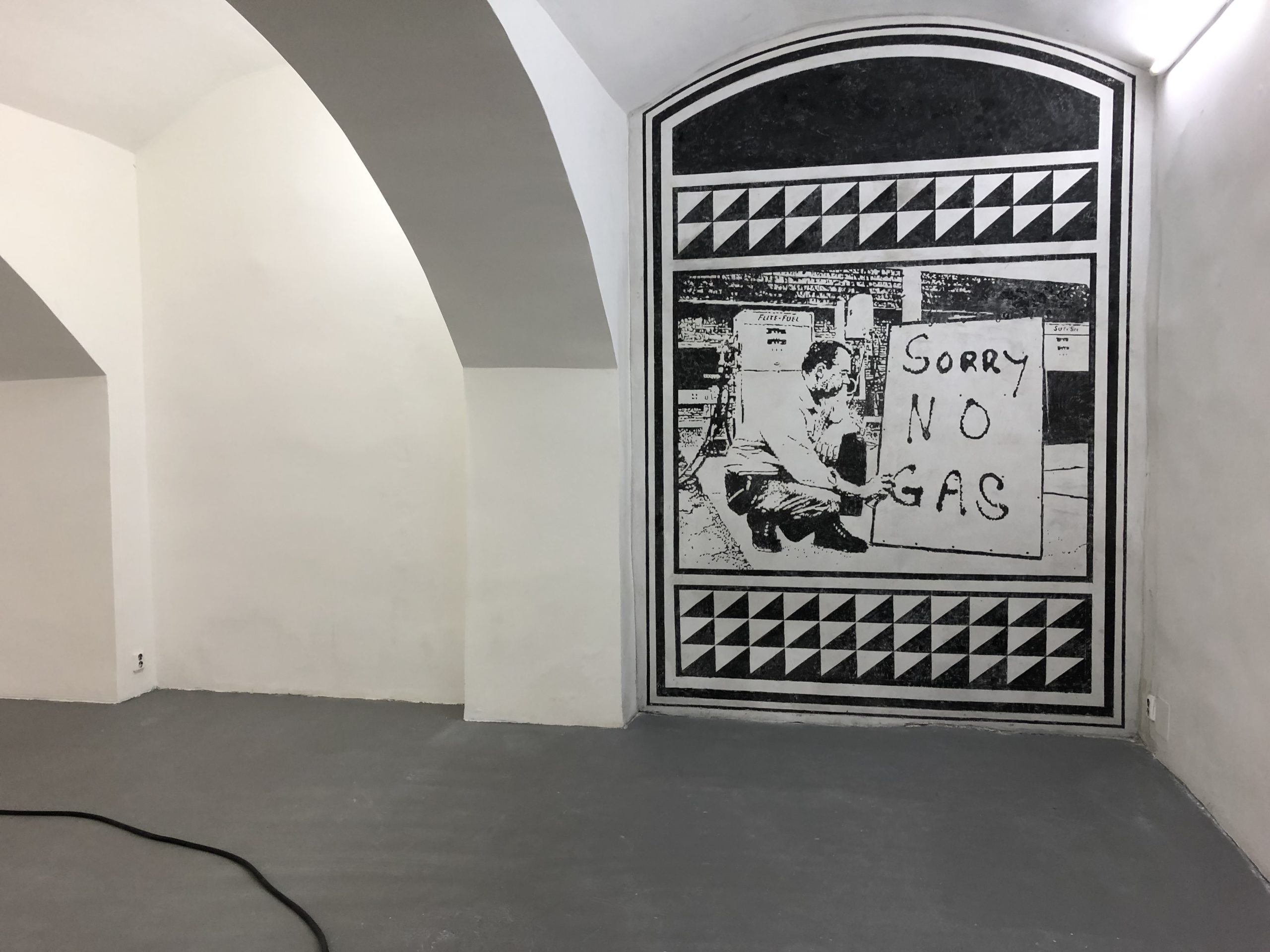
Install: Devon Dikeou, Ring My Bell, 2017-ongoing, working Milton Driveway Bell, Hose, and Anchor, variable dimensions; Devon Dikeou, Gas Shortage, 2018-ongoing, Google Image of 1973 Gas Shortage Etched in Wall Using the Sgrafitto technique, variable dimensions
For the past two months, Devon Dikeou has been in Prague, Czech Republic, an artist-in-residence at Centre for Contemporary Art FUTURA as part of Black Cube Nomadic Museum’s fellowship program. Curated by Black Cube’s Cortney Lane Stell, Dikeou’s exhibition Tricia Nixon: Summer of 1973 captures the essence of America during the 1970s, while drawing parallels to present-day crises and politics in the U.S. Pulling from public record and personal memory of the era, Dikeou tells the backstories of the various elements that comprise the installation and how it echoes a time from decades past as well as reflects what is happening now in our current time. Tricia Nixon: Summer of 1973 is on view at FUTURA through September 16, 2018.
Interview by Hayley Richardson
This is your second artist residency, the first one being at Artpace in San Antonio in 2011. What do you value the most from the residency experience?
Well residencies often imply studio. My studio is wherever I am—be that a city, a country, a locale, a room, an exhibition space, and the atmosphere—music, TV, cafés, bars, museums, other artists’ studios, and what you sense there . . . but I do come to all things—exhibitions, residencies, fairs, magazine projects, with my thoughts pretty worked out. The fun and beauty, and I guess value is when they—those thoughts—change . . . What happened in Prague is that once I got to Futura . . . There were extra exhibition spaces available, and the idea of commingling the spaces somehow became attractive, joining them in a way . . . And as my work is really about finding these pockets of in-between, the meandering spaces of Futura were just delicious . . . How could I make them more related beyond just ideas . . .
And beyond that initial response . . . I want to say . . . There’s this great story of Joan Rivers . . . She used to archive all her jokes in an old-fashioned library card catalogue manner. So, she had categories and alphabetized the jokes, and when she needed one, all she had to do was consult this card catalogue—and as time went on, this file became a massive archive . . . A whole room with the little wooden drawers, and 4” x 6” cards full of jokes for when she didn’t have one. And instead of a search engine, she searched her own search engine.
So, as I was arriving in Prague, I was looking at old legal pads which is my archive system of pieces, and I came across a piece which I thought fit really nicely with the “Tricia Nixon: Summer of 1973.” I found “Ring My Bell” (1991 Ongoing). It relates to the gas crisis of ‘73, the lines, the idea of full-service, consumption, and found object, relational aesthetics ideas of activation, and minimal ideas of composition, line, presence, and lack thereof. It seemed like a perfect pairing. And I began to connect the spaces in Futura, not just with ideas but with literal hoses, anchors, and bells—which is how “Ring My Bell” exits as a functioning gas station bell . . . Actually, back then we used to call them “Service Stations,” the attendants come to service you once the bell has rung.
Also, something happens when you get out of your element, in a residency . . . It’s why I love visiting all 17 curatorial departments of the MET . . . Or any encyclopedic museum . . . There is something inspiring about things you don’t know that well, but can appreciate, and if that can enter your practice, so much the better. In Prague, just wandering around I became reintroduced to an old technique called Sgrafitto. I just loved it, seeing it again . . . It’s wood block printing meets fresco, meets batik, meets decoration, meets architecture, the etymology of which produced the modern practice and word, graffiti. I thought why not reverse the process and use an old technique to create something nostalgic even in our contemporary mindset of 2018, from 1973, and convey something, not just technique or decor, that relates to our own encyclopedia of reference. So now we a have piece made in a residency that may or may not have ever come to fruition without the lovely coincidence/gift of Prague, Futura/Black Cube Residency.
The exhibition centers around the U.S. oil crisis of 1973, specifically the then-president’s daughter Tricia Nixon’s frivolous behavior during this time when the rest of the nation was subjected to rationing and conservation of resources. The installation “Summer of 1973: Tricia Nixon” features a faux fire element with marble fireplace, a modern-day air conditioner, and vintage Mickey Mouse clock radio among other objects reminiscent of that time and now. What are the backstories to the different elements of the exhibition?
I live in a loft where the heat is super old school. It’s steam, no control, can’t turn it up, can’t turn it down. When it’s hot you’re in a Russian bath, if it’s freezing, then of course it doesn’t work, and there’s no adjustment available either way. And it screams literally every time it fires up . . . Sounds like someone is breaking in . . . Nothing to be done. There is this tiny room in the loft that I like to go to and just think . . . Virginia Woolf, “Room of One’s Own” style, and sort out the start of the day . . . There I am in this blank white room with a somewhat modern window air conditioner with an old-fashioned steam heater painted silver below it. The heater starts its initial wheezing, graduates to clanking, and bangs out what sounds like Beethoven No. 9. As I was sitting there, in this tiny room, with these two elements of heat and coolness, I was reminded of that 1973 summer—old enough then to comprehend what was happening—and bling: Tricia Nixon. Which brings us to this story that I recall of Tricia turning up the air conditioner in the White House so high so that she could have a fire in one of those over-the-top fireplaces, all in the heat of a D.C. summer. Maybe it’s urban myth, but the craziness of the gesture has somehow stuck with me. And in the spirit of “if these rooms could speak,” from the cranky old loft that spoke to me that morning and reminded me of what may or may not have happened in the White House, this installation germinated . . . So we have a bricolage of White House rooms with replication of different elements from several, essentially a working fireplace, a modern air conditioner, and a clock radio from 1973, which is the radio I listened to every night before going to sleep and woke up to get ready for school. It was a Disney clock radio, and I just a bit too old to really have it, but the dial was a 3-D Mickey, and even though he’s not even my favorite character, I love it dearly both then and today plus it functions! That analog clock radio in the installation serves as the platform from which I learned about Tricia Nixon’s fireplace/air conditioner misstep, and now in our digital age plays CBS news clips from the summer in ’73, including those clips reporting on Watergate, the Pentagon Papers, the sounds of the summer in rock -n- roll, and advertisements. These elements pull the viewer into a new, in-between space, the hallway in fact, and hopefully remind/poke them to think about the relationship of the gesture of combining air conditioning and fire, as well as crisis, privilege, corruption, information, culture, time, much less space, and its value, and any art historical stuff they might have archived in their own memory.
Do you feel “Summer of 1973: Tricia Nixon” takes on a different meaning being exhibited in Eastern Europe compared to the United States?
Well, people say context is everything . . . I hope the three pieces speak universally to a host of different things we can all appreciate. Naturally, that appreciation will fluctuate between cultures, politics, gender, age, geography, history—art or otherwise. They say Prague is the Paris of the East, but I’ve learned from a very reputable source that Paris is the Prague of the West. Let’s see how East reads West, or is it the other way around . . .